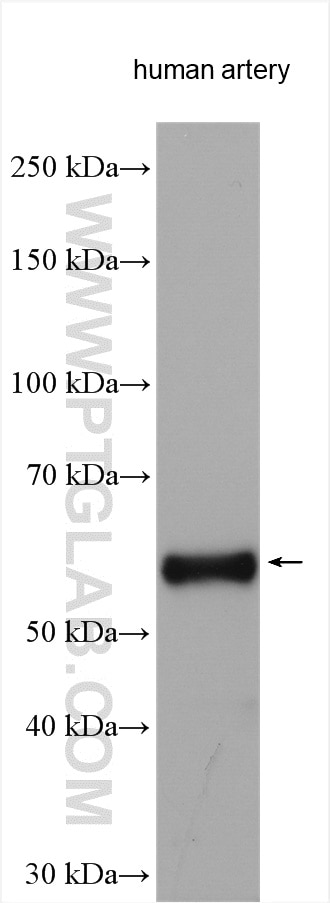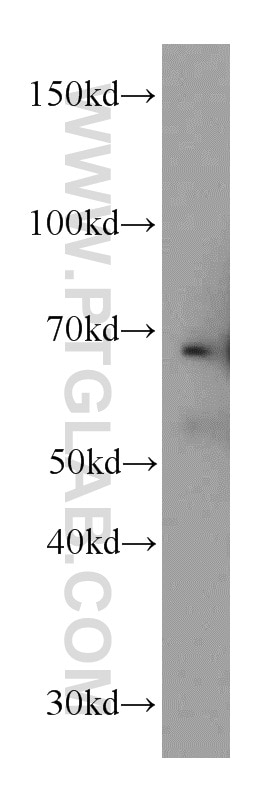Elastin Polyklonaler Antikörper
Elastin Polyklonal Antikörper für IHC, IP, WB, ELISA
Wirt / Isotyp
Kaninchen / IgG
Getestete Reaktivität
human
Anwendung
WB, IP, IHC, IF, ELISA
Konjugation
Unkonjugiert
Kat-Nr. : 15257-1-AP
Synonyme
Galerie der Validierungsdaten
Geprüfte Anwendungen
| Erfolgreiche Detektion in WB | humanes Arteriengewebe |
| Erfolgreiche IP | humanes Plazenta-Gewebe |
| Erfolgreiche Detektion in IHC | humanes Lungengewebe, humanes Hautkrebsgewebe Hinweis: Antigendemaskierung mit TE-Puffer pH 9,0 empfohlen. (*) Wahlweise kann die Antigendemaskierung auch mit Citratpuffer pH 6,0 erfolgen. |
Empfohlene Verdünnung
| Anwendung | Verdünnung |
|---|---|
| Western Blot (WB) | WB : 1:1000-1:5000 |
| Immunpräzipitation (IP) | IP : 0.5-4.0 ug for 1.0-3.0 mg of total protein lysate |
| Immunhistochemie (IHC) | IHC : 1:500-1:2000 |
| It is recommended that this reagent should be titrated in each testing system to obtain optimal results. | |
| Sample-dependent, check data in validation data gallery | |
Veröffentlichte Anwendungen
| WB | See 11 publications below |
| IHC | See 2 publications below |
| IF | See 2 publications below |
Produktinformation
15257-1-AP bindet in WB, IP, IHC, IF, ELISA Elastin und zeigt Reaktivität mit human
| Getestete Reaktivität | human |
| In Publikationen genannte Reaktivität | human |
| Wirt / Isotyp | Kaninchen / IgG |
| Klonalität | Polyklonal |
| Typ | Antikörper |
| Immunogen | Elastin fusion protein Ag7179 |
| Vollständiger Name | elastin |
| Berechnetes Molekulargewicht | 68 kDa |
| Beobachtetes Molekulargewicht | 60-70 kDa |
| GenBank-Zugangsnummer | BC065566 |
| Gene symbol | ELN |
| Gene ID (NCBI) | 2006 |
| Konjugation | Unkonjugiert |
| Form | Liquid |
| Reinigungsmethode | Antigen-Affinitätsreinigung |
| Lagerungspuffer | PBS mit 0.02% Natriumazid und 50% Glycerin pH 7.3. |
| Lagerungsbedingungen | Bei -20°C lagern. Nach dem Versand ein Jahr lang stabil Aliquotieren ist bei -20oC Lagerung nicht notwendig. 20ul Größen enthalten 0,1% BSA. |
Hintergrundinformationen
Elastic fibers are an abundant and integral part of many extracellular matrices, in which they provide the elastic properties to tissues such as arterial, lung, and skin. Elastic fibers are consisting of an elastin core surrounded by a mantle of fibrillin-rich microfibrils (PMID: 12082143). Elastin is an extremely durable, insoluble biopolymer formed through the lysine-mediated crosslinking of its soluble precursor tropoelastin, which is an approximately 60-70 kDa protein (PMID: 15837523). Deletions and mutations in the elastin gene (ELN) are associated with supravalvular aortic stenosis (SVAS) and autosomal dominant cutis laxa.
Protokolle
| Produktspezifische Protokolle | |
|---|---|
| WB protocol for Elastin antibody 15257-1-AP | Protokoll herunterladen |
| IHC protocol for Elastin antibody 15257-1-AP | Protokoll herunterladen |
| IP protocol for Elastin antibody 15257-1-AP | Protokoll herunterladen |
| Standard-Protokolle | |
|---|---|
| Klicken Sie hier, um unsere Standardprotokolle anzuzeigen |
Publikationen
| Species | Application | Title |
|---|---|---|
Am J Respir Cell Mol Biol Glutaminolysis Promotes Collagen Translation and Stability via α-ketoglutarate Mediated mTOR Activation and Proline Hydroxylation. | ||
Int J Mol Sci αvβ3 Integrin as a Link between the Development of Fibrosis and Thyroid Hormones in Systemic Sclerosis | ||
J Cell Physiol Novel insight into the role of clusterin on intraocular pressure regulation by modifying actin polymerization and extracellular matrix remodeling in the trabecular meshwork. | ||
Cells Cathepsin K Regulates Intraocular Pressure by Modulating Extracellular Matrix Remodeling and Actin-Bundling in the Trabecular Meshwork Outflow Pathway. | ||
Front Pharmacol The Extracellular Matrix Enriched With Exosomes for the Treatment on Pulmonary Fibrosis in Mice | ||
Am J Physiol Cell Physiol miR-29c Induction Contributes to Down-Regulation of Vascular Extracellular Matrix Proteins by Glucocorticoids. |










